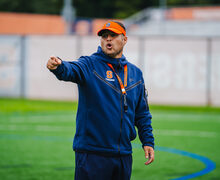DiBona: Colbert must engage multiple audiences for ‘Late Show’ success
Expectations can be crippling, especially when you’re on national TV.
This is why if you watched the opening monologue of the first episode of “The Late Show with Stephen Colbert,” he didn’t seem completely comfortable. But why would the face of one of the most successful shows of the past 10 years be nervous about anything?
Then it hit me: Colbert has delivered countless monologues on television, but this is the first one he’s given standing up on a stage that reaches more people than even “The Colbert Report.” The expectations for him have changed, but more importantly, they’ve grown.
If Colbert wants to find true success with “The Late Show,” he’s going to need to find a balance between the different types of crowds tuning in. He must appeal to three key audiences: the audience from “The Colbert Report,” the modern viewers of “The Late Show” and the audience who longs for a return to the stranger years of “The Late Show” past.
This same was true when Conan O’Brien took over “The Tonight Show.” Though Conan and his “Late Night” had garnered a large following, Conan’s version ultimately flopped when he took over “The Tonight Show” because he refused to compromise his idiosyncratic style with the broader comedy of Jay Leno.
When Jimmy Fallon took over for O’Brien, he faced a similar set of responsibilities, but handled the transition perfectly. Fallon seamlessly merged his “Late Night” audience with Leno’s “The Tonight Show” one, finding a balance between his odder pop culture-centric segments with Leno-style monologues and respectful interview tendencies.
Fallon has been the leader in late night for his whole tenure not necessarily because of the people who love him, but because of the people who don’t hate him. Colbert’s task is similar, but harder because he has even larger factions of viewers to take on.
Though Colbert seemed shaken up at the start, he has gotten more comfortable.
He’s appeased fans of his old show by including things like a takedown of the media coverage of Donald Trump, which was as satirically brilliant as anything from “The Colbert Report.” He’s also continued to have interviews that appeal to the intellectual crowd including, discussions with presidential candidate Jeb Bush and technology magnate Elon Musk. He’s also appeased the modern Letterman fan by keeping the general format of the show as well as aping Letterman’s famous off-putting attitude.
But it’s the third demographic of viewers who are nostalgic for the stranger years of “The Late Show” that’s proved the hardest to capture.
Colbert’s premier episode featured a segment involving a demonic skull demanding Colbert to advertise Sabra hummus or face damnation. It was mildly funny, but it was more of a statement from Colbert: this is sometimes going to get weird. It’s the maintenance of this third audience that will make or break “The Late Show with Stephen Colbert.”
Colbert’s never had to face expectations like this, but he has always blown past expectations ever since he outgrew his role as a correspondent back on “The Daily Show.” His new success is going to come from a new, larger audience, but there’s no doubt he’s going to give them everything he’s got. After all, that’s all someone with his kind of talent can do.
Mark DiBona is a senior television, radio and film major. His column appears weekly. He can be reached at [email protected] and followed on Twitter @NoPartyNoDisco.
Published on September 15, 2015 at 12:06 am





